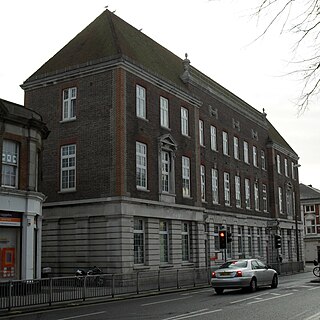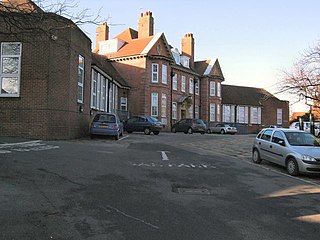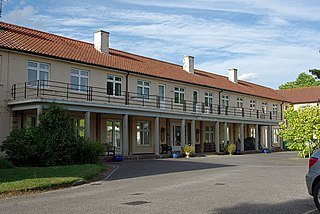
West Sussex is a ceremonial county in South East England. Established in 1974 from the western half of Sussex, it is bordered by Surrey to the north, East Sussex to the east, the English Channel to the south, and Hampshire to the west. The county town is the city of Chichester, and the largest settlement is Crawley.

Littlehampton is a town, seaside resort and civil parish in the Arun District of West Sussex, England. It lies on the English Channel on the eastern bank of the mouth of the River Arun. It is 52 miles (84 km) south south-west of London, 19 miles (31 km) west of Brighton and 10 miles (16 km) east of the county town of Chichester.

Arun is a local government district in West Sussex, England. Its council is based in Littlehampton. The district's other towns are Arundel and Bognor Regis. The district is named after the River Arun, which runs through the centre of the district.

Chichester is a cathedral city and civil parish in West Sussex, England. It is the only city in West Sussex and is its county town. It was a Roman and Anglo-Saxon settlement and a major market town from those times through Norman and medieval times to the present day. It is the seat of the Church of England Diocese of Chichester, with a 12th-century cathedral.

The A27 is a major road in England. It runs from its junction with the A36 at Whiteparish in the county of Wiltshire, follows the south coast of Hampshire and West Sussex, and terminates at Pevensey in East Sussex.

A rape is a traditional territorial sub-division of the county of Sussex in England, formerly used for various administrative purposes. Their origin is unknown, but they appear to predate the Norman Conquest. Historically the rapes formed the basis of local government in Sussex.

Yapton is a village and civil parish in the Arun District of West Sussex, England. It is centred three miles (4.8 km) north east of Bognor Regis at the intersection of the B2132 and B2233 roads.

St Richard's Hospital is a medium-sized District General Hospital (DGH) located in Chichester, West Sussex, England. It is now part of University Hospitals Sussex.

Worthing Hospital is a medium-sized District General Hospital (DGH) located in Worthing, West Sussex, England. It is managed by University Hospitals Sussex NHS Foundation Trust.

Crawley Hospital is a National Health Service hospital in Crawley, a town and borough in West Sussex, England. Since 2006 it has been part of the Sussex Community NHS Trust, which has overall management responsibility. Surrey and Sussex Healthcare NHS Trust also provides some services. The hospital is located in the West Green neighbourhood of Crawley, near the town centre.

Worthing, a seaside town in the English county of West Sussex which has had borough status since 1890, has a wide range of public services funded by national government, West Sussex County Council, Worthing Borough Council and other public-sector bodies. Revenue to fund these services comes principally from Council Tax.

All Saints Church is the Anglican parish church of Roffey, in the Horsham district of the English county of West Sussex. The present church, built to serve the Victorian suburb of Roffey—part of the ancient market town of Horsham—replaced a schoolroom in which religious services had been held since 1856. Arthur Blomfield's Early English-style church, built of locally quarried sandstone and funded by a widow as a memorial to her late husband, was completed in 1878 and was allocated a parish immediately. Roman Catholic services were also held in the building to serve Roffey's Catholic population, but these ceased in the early 21st century. English Heritage has listed the church at Grade II for its architectural and historical importance.

The Rape of Chichester is one of the rapes, the traditional sub-divisions unique to the historic county of Sussex in England. The most westerly of the Sussex rapes, the rape of Chichester is a former barony, originally centred on Chichester Castle in the city of Chichester.

Brighton General Hospital is an acute general hospital on Elm Grove in Brighton, East Sussex. It is managed by Sussex Community NHS Trust. The main Arundel building is Grade II listed.

Horsham Hospital is a health facility at Hurst Road in Horsham, West Sussex, England. It is managed by Sussex Community NHS Foundation Trust.
Bognor Regis War Memorial Hospital is a health facility in Shripney Road, Bognor Regis, West Sussex, England. It is managed by Sussex Community NHS Foundation Trust.

Lewes Victoria Hospital is a health facility at Nevill Road in Lewes, East Sussex, England. It is managed by NHS Property Services with services operated principally by Sussex Community NHS Foundation Trust, Sussex Partnership NHS Foundation Trust, University Hospitals Sussex NHS Foundation Trust, East Sussex Healthcare NHS Trust, and with parts of community medical cover provided by general practitioners from Foundry Healthcare Lewes, the local primary care network.

Zachary Merton Hospital is a health facility at Glenville Road, Rustington, West Sussex, England. It is managed by the Sussex Community NHS Foundation Trust.

Brighton and Hove, a city and unitary authority in the English county of East Sussex, has a wide range of public services funded by national government, East Sussex County Council, Brighton and Hove City Council and other public-sector bodies. Revenue to fund these services comes partly from Council Tax, which is paid annually by residents: this tax provides the city council with nearly 20% of its income and also helps to fund the local police force, Sussex Police, and the county's fire service, East Sussex Fire and Rescue Service. Some of Brighton and Hove's utilities and infrastructure are provided by outside parties, such as utility companies, rather than by the city council.



















